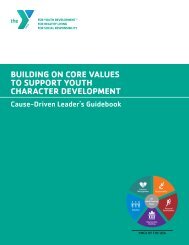CDLI_Guidebook_18_Final_Print
Create successful ePaper yourself
Turn your PDF publications into a flip-book with our unique Google optimized e-Paper software.
PROGRAM/ORGANIZATION LEVEL<br />
EMOTION MANAGEMENT: Adults support youth to be aware of and constructively handle both positive and challenging emotions.<br />
Key Feature<br />
Youth<br />
Development<br />
Competency Strategy Indicator Behavior<br />
Examples<br />
(Not exclusive or applicable<br />
to all ages)<br />
Appropriate<br />
Structure and<br />
Routine<br />
A. Functional<br />
Expertise<br />
B. Quality Results<br />
A. Adults assess the<br />
youth's emotional<br />
readiness and adjust<br />
and engage in<br />
response to the data.<br />
A. Ys use researchbased<br />
valid assessment<br />
tools such as youth<br />
surveys (i.e. HSA from<br />
PEAR, Algorhthym<br />
Youth survey) to<br />
measure youth<br />
stakeholder input.<br />
B. The Y adopts and<br />
uses a research based<br />
character development<br />
curriculum.<br />
C. Y leadership creates<br />
accountability metrics<br />
for staff and volunteers<br />
to deepen one-to-one<br />
relationships with<br />
youth.<br />
A. The Youth Development Leader<br />
recognizes the social-emotional,<br />
cognitive, and physical milestones<br />
youth experience during their<br />
journey from birth to career.<br />
B. The Youth Program Staff and<br />
Leaders actively implement<br />
regular evaluations of program<br />
goals, the program environmental<br />
quality and program outcomes.<br />
C. The Y uses data to highlight<br />
youth achievement and progress<br />
to key stakeholders and<br />
community partners.<br />
1. Staff conduct an annual needs<br />
assessment of the condition and<br />
types of equipment available to<br />
youth; if adjustments are needed,<br />
Y Association leadership reallocates<br />
resources or raises funds.<br />
2. Ys include a quick survey for<br />
campers' parents/caregivers to<br />
complete as a part of the camper<br />
application. Afterwards, each<br />
counselor creates a personalized<br />
youth engagement plan for<br />
each camper.<br />
3. Ys conduct a SEL Program<br />
Quality Assessment (self and<br />
external) and discuss the<br />
outcomes as a team.<br />
Supportive<br />
Relationships<br />
A. Relationships<br />
B. Functional<br />
Expertise<br />
C. Developing<br />
Others<br />
A. The physical<br />
environment<br />
nurtures<br />
appropriate<br />
cognitive, physical,<br />
and, social youth<br />
development.<br />
B. The Youth<br />
Development<br />
Leader recognize<br />
that all youth have<br />
individual needs,<br />
temperaments,<br />
characteristics<br />
and abilities and<br />
develop at their<br />
own rate.<br />
C. Leadership<br />
promotes and<br />
provides systems<br />
for staff well being.<br />
A. Materials &<br />
resources are made<br />
available to staff to<br />
help identify and<br />
maintain their own<br />
emotional<br />
well being.<br />
B. Adults encourage<br />
a culture where<br />
youth can<br />
appropriately optout<br />
of program<br />
activities.<br />
C. Y leadership<br />
create accountability<br />
metrics for staff to<br />
deepen one-to-one<br />
relationships with<br />
youth.<br />
A. Adults create safe spaces<br />
for youth to retreat and have<br />
appropriate personalized,<br />
reflection time.<br />
B. A system is in place for<br />
youth to regular monitor<br />
and express their individual<br />
emotions.<br />
1. Program spaces are<br />
accommodating to meet youth<br />
needs (i.e. flexible furniture,<br />
appropriate size furniture,<br />
comfortable furniture). Youth<br />
have options to move freely<br />
through the program space at<br />
appropriate times.<br />
2. An emoji chart is available and<br />
displayed to help youth express<br />
their emotions.<br />
3. Multiple signs are displayed<br />
around the teen center that<br />
encourage mental wellness and<br />
reflection (e.g., "How will you<br />
make the most of today?"<br />
"The golden rule," and "LGBT<br />
Safe Zone").<br />
Opportunity<br />
for Skill<br />
Building<br />
A. Developing Others<br />
B. Functional<br />
Expertise<br />
A. Y Leadership<br />
creates a plan<br />
for intentional<br />
recruitment,<br />
onboarding<br />
and orientation<br />
activities with the<br />
adults responsible<br />
for character<br />
development.<br />
B. Y Leadership<br />
provides ongoing<br />
Youth Development<br />
training opportunities<br />
for Emotion<br />
Management.<br />
A. Y Leadership<br />
establishes a<br />
recruitment pipeline<br />
for staff and volunteers<br />
from internal and<br />
local community<br />
organizations.<br />
B. Y Leadership<br />
establishes professional<br />
development<br />
and career path<br />
opportunities for staff.<br />
A. Y Leadership schedules<br />
regular training to review and<br />
learn healthy strategies and<br />
behaviors for supporting youth to<br />
deal with their emotions.<br />
1. Existing and new staff receive<br />
training on Emotion Management<br />
techniques.<br />
2. Staff members are given time<br />
once a week, or at the end of<br />
the program time, to reflect and<br />
get support from other staff to<br />
address any youth issues that<br />
were identified.<br />
3. Staff communicate with each<br />
other and share best practices for<br />
interacting with youth.<br />
4. Provide staff with Listen<br />
First training.<br />
CHARACTER DEVELOPMENT GUIDEBOOK<br />
P 60



